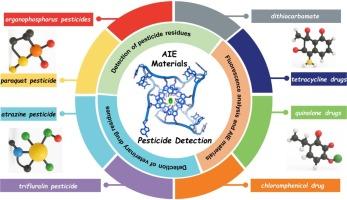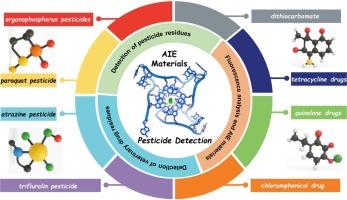Aggregation-induced emission materials for fluorescence analysis: Recent progress in rapid detection of pesticide and veterinary drug residues
IF 23.5
1区 化学
Q1 CHEMISTRY, INORGANIC & NUCLEAR
引用次数: 0
Abstract
Pesticides and veterinary drugs are indispensable for crop cultivation, protection, and storage. However, concerns regarding their persistent residues in soil, water, and agricultural products, which lead to significant environmental pollution and human health risks, cannot be overlooked. Consequently, the urgent development of sensitive, effective, simple, rapid, and user-friendly methods for quantitative residue detection is essential. Fluorescence analysis, characterized by its intuitive readout, high sensitivity, simplicity, speed, and ease of operation, has emerged as a primary technique for this purpose. Aggregation-induced emission (AIE) materials offer a distinct advantage by overcoming the ubiquitous aggregation-caused quenching (ACQ) effect inherent in conventional fluorophores. With high fluorescence quantum yield, tunable photophysical properties, good photostability, and excellent stability, AIE materials provide very slight background signals and high signal intensity, making them extremely effective probes for pesticide and veterinary drug detection. Recent trends in AIE development focus on designing multifunctional and smart probes, integrating AIE materials with portable and on-site detection platforms, and expanding applications toward multiplexed and real-time analysis. This comprehensive review critically surveys the application of AIE material-based fluorescence analysis for detecting various pesticide residues (such as organophosphorus pesticides, paraquat, atrazine, trifluralin, and dithiocarbamates) and veterinary drug residues (including tetracyclines, quinolones, and chloramphenicol). By highlighting recent advancements and key design strategies, this review aims to stimulate further innovation in AIE-based sensors and accelerate their translation into practical, commercial detection technologies to safeguard food safety and environmental health.


荧光分析用聚集诱导发射材料:农药兽药残留快速检测研究进展
农药和兽药是农作物种植、保护和储存中不可缺少的。然而,它们在土壤、水和农产品中的持续残留导致严重的环境污染和人类健康风险的问题不容忽视。因此,迫切需要开发灵敏、有效、简单、快速、用户友好的残留定量检测方法。荧光分析以其直观的读数、高灵敏度、简单、快速和易于操作为特点,已成为这一目的的主要技术。聚集诱导发射(AIE)材料具有明显的优势,克服了传统荧光团中普遍存在的聚集引起的猝灭(ACQ)效应。AIE材料具有荧光量子产率高、光物理性质可调、光稳定性好、稳定性优异等特点,提供非常微弱的背景信号和高的信号强度,是非常有效的农药、兽药检测探针。AIE发展的最新趋势集中在设计多功能和智能探头,将AIE材料与便携式和现场检测平台集成,并向多路复用和实时分析扩展应用。本文综述了基于AIE材料的荧光分析在检测各种农药残留(如有机磷农药、百草枯、阿特拉津、三氟灵和二硫代氨基甲酸酯)和兽药残留(包括四环素类、喹诺酮类和氯霉素)方面的应用。通过强调最近的进展和关键的设计策略,本综述旨在刺激基于人工智能的传感器的进一步创新,并加速其转化为实用的商业检测技术,以保障食品安全和环境健康。
本文章由计算机程序翻译,如有差异,请以英文原文为准。
求助全文
约1分钟内获得全文
求助全文
来源期刊

Coordination Chemistry Reviews
化学-无机化学与核化学
CiteScore
34.30
自引率
5.30%
发文量
457
审稿时长
54 days
期刊介绍:
Coordination Chemistry Reviews offers rapid publication of review articles on current and significant topics in coordination chemistry, encompassing organometallic, supramolecular, theoretical, and bioinorganic chemistry. It also covers catalysis, materials chemistry, and metal-organic frameworks from a coordination chemistry perspective. Reviews summarize recent developments or discuss specific techniques, welcoming contributions from both established and emerging researchers.
The journal releases special issues on timely subjects, including those featuring contributions from specific regions or conferences. Occasional full-length book articles are also featured. Additionally, special volumes cover annual reviews of main group chemistry, transition metal group chemistry, and organometallic chemistry. These comprehensive reviews are vital resources for those engaged in coordination chemistry, further establishing Coordination Chemistry Reviews as a hub for insightful surveys in inorganic and physical inorganic chemistry.
 求助内容:
求助内容: 应助结果提醒方式:
应助结果提醒方式:


